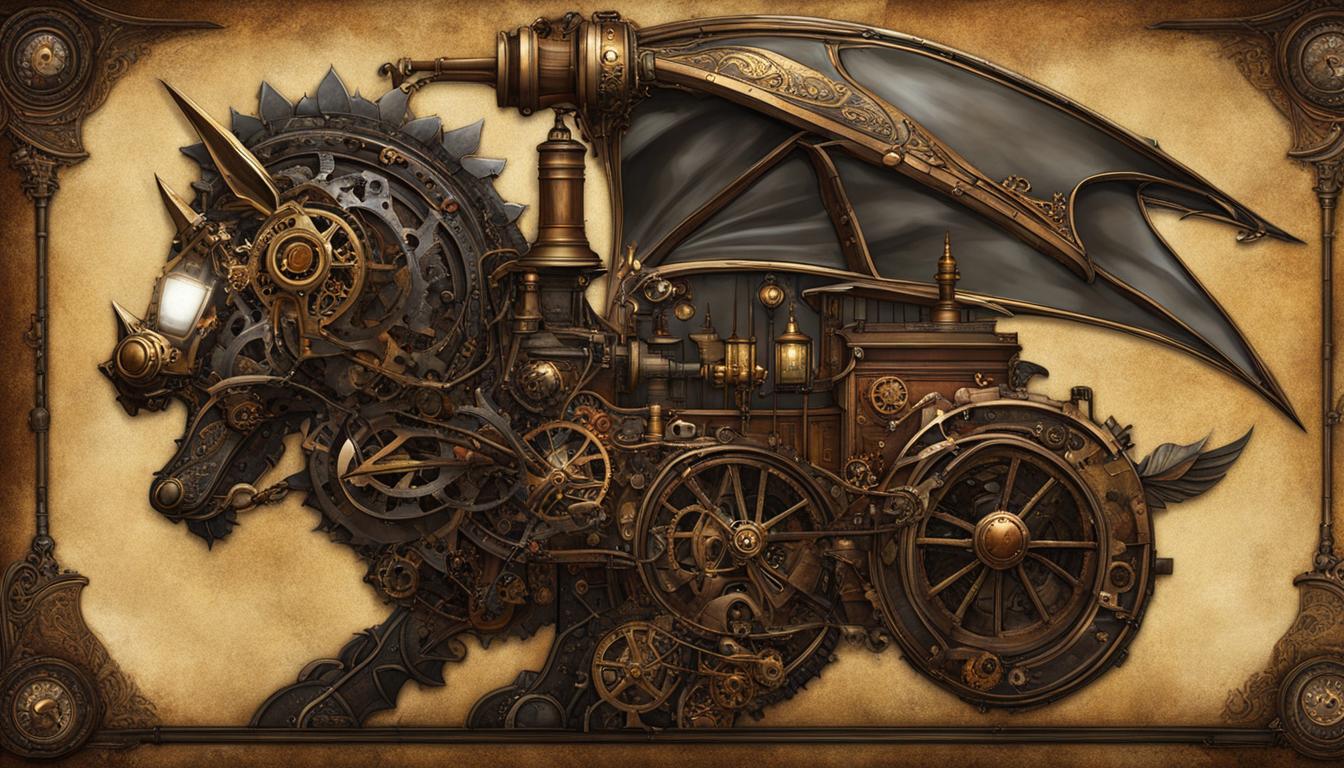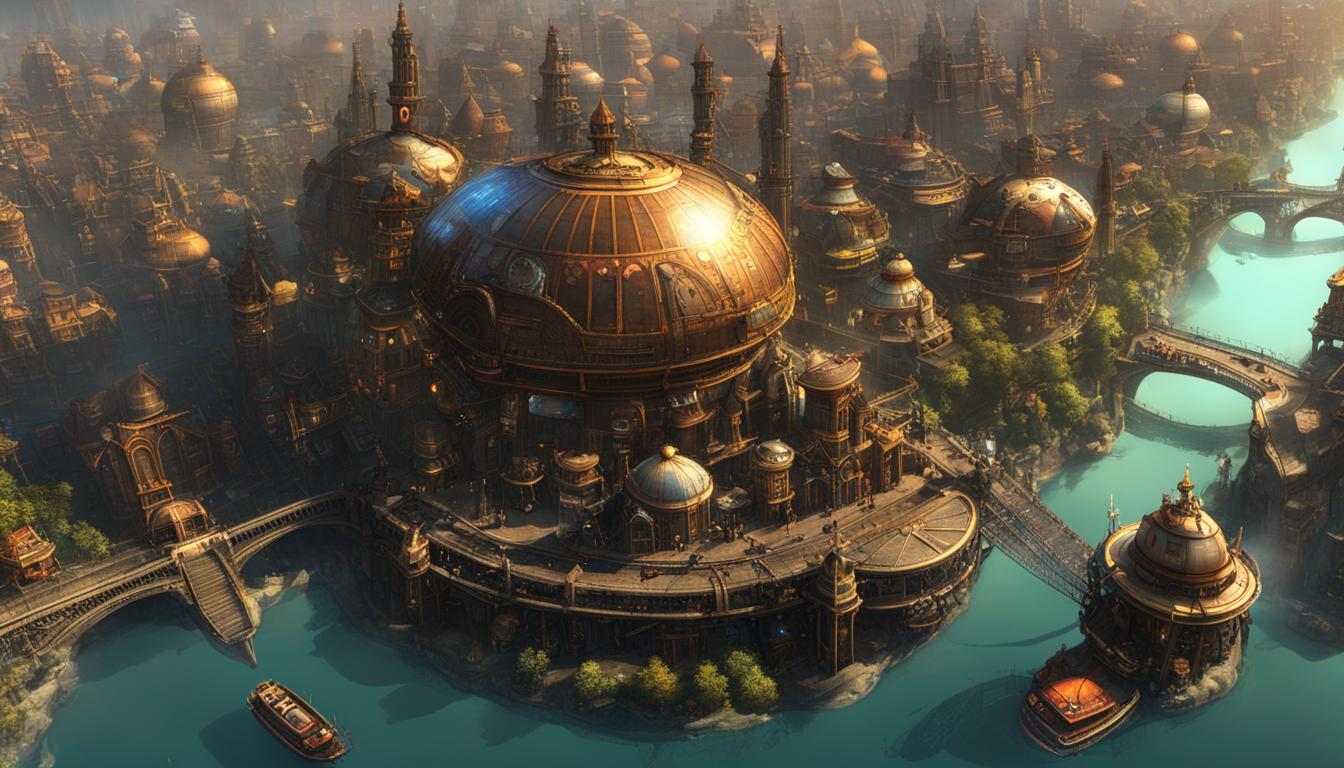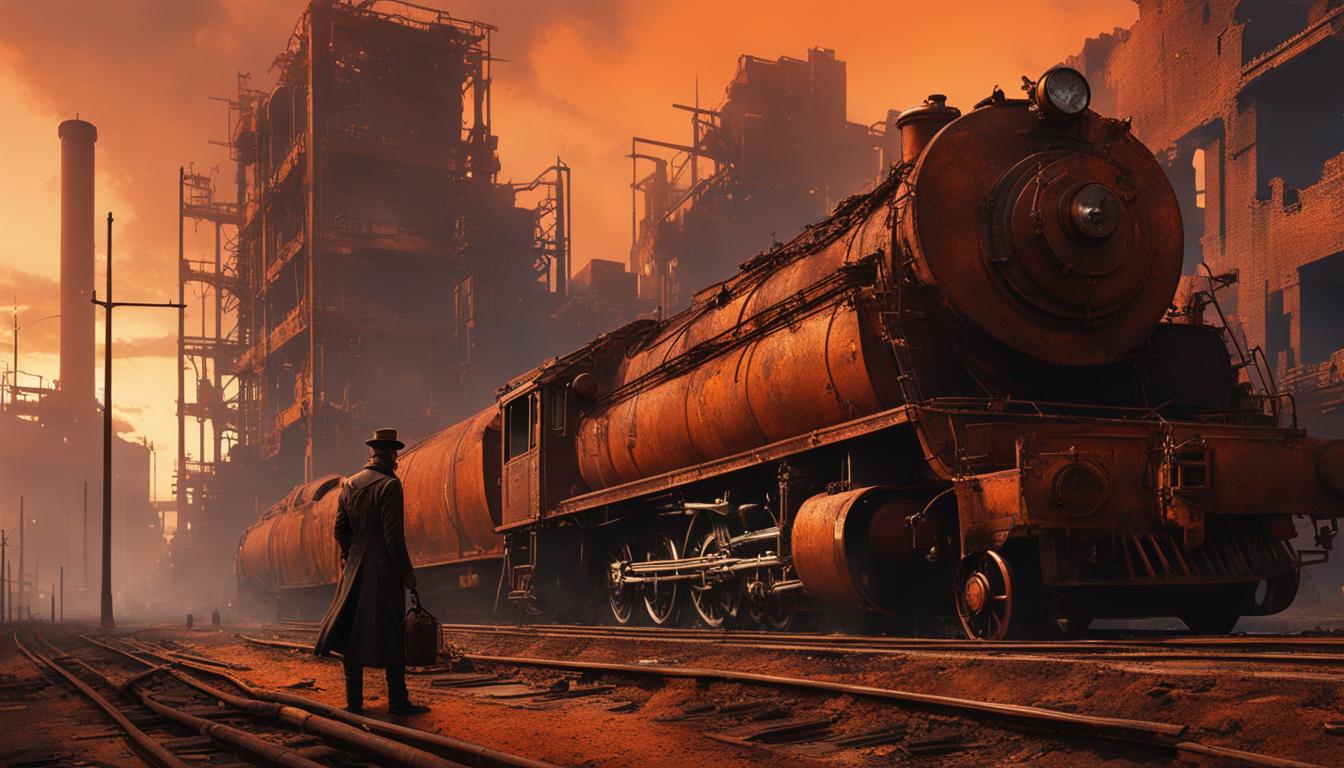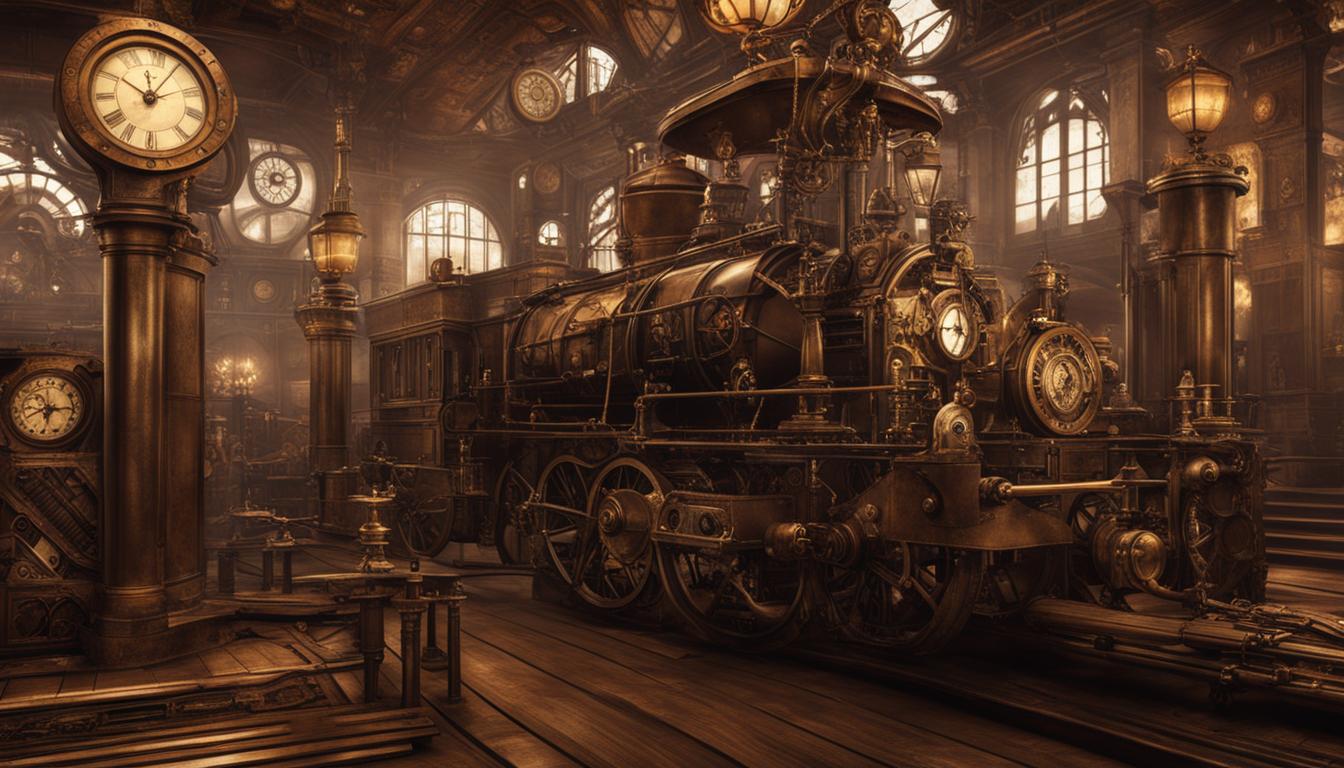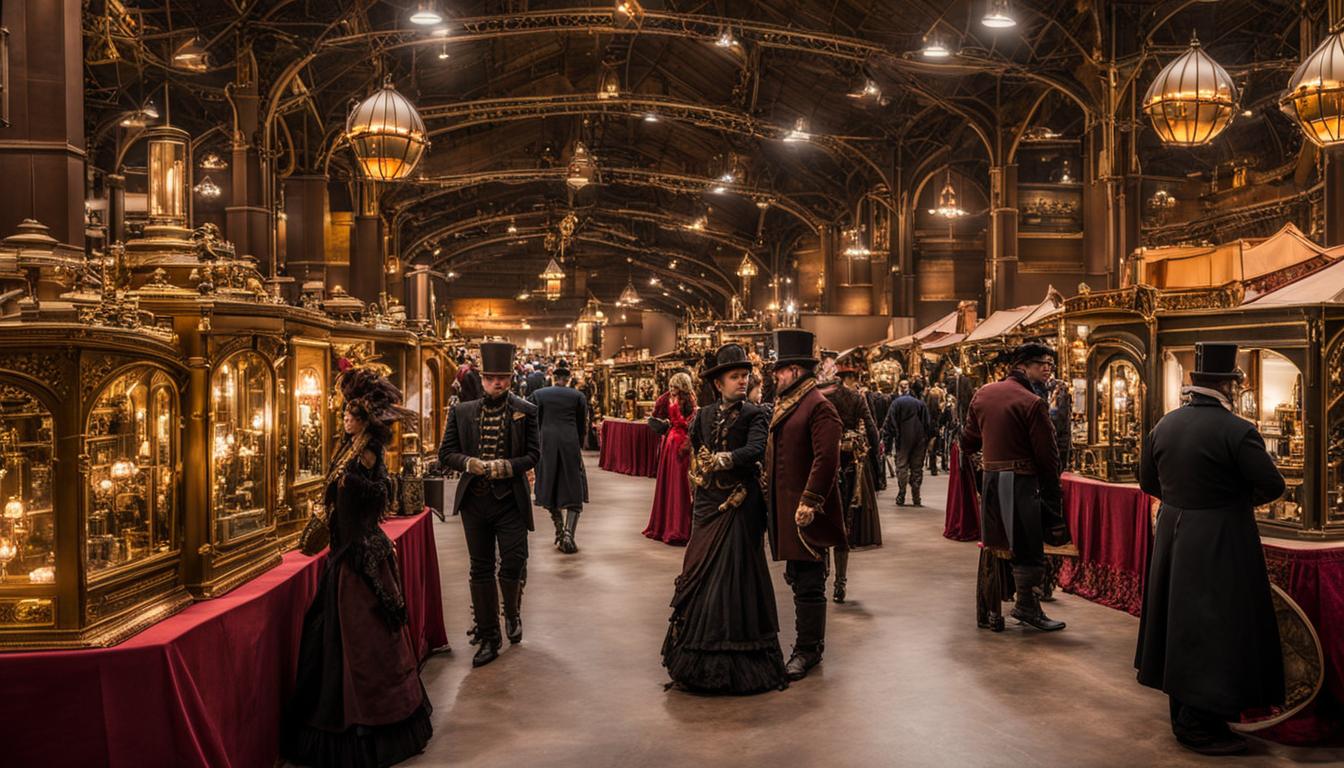Steampunk’s transformation of fantasy literature has been nothing short of remarkable. This unique genre, combining elements of science fiction, fantasy, and alternative history, has brought a breath of fresh air to the world of fantasy novels. With its blend of Victorian charm, imaginative world-building, and anachronistic technology, steampunk has revolutionized the genre, captivating readers with its captivating mix of technology, magic, and social critique.
Key Takeaways:
- Steampunk has introduced unique themes, settings, and characters to fantasy literature.
- It combines the aesthetics of the Victorian era with fantastical elements and anachronistic technology.
- Steampunk has influenced a wide range of fantasy novels with its captivating narratives.
- The fusion of historical elements, imaginative technology, and social critique has made steampunk a beloved subgenre within fantasy literature.
- Readers are drawn to the vintage charm, immersive world-building, and captivating blend of magic and technology that steampunk offers.
The Essence of Steampunk in Literature
Steampunk in literature embodies a unique blend of vintage charm, imaginative technology, and alternative history. This genre pays homage to the fashion and aesthetics of the Victorian era while introducing anachronistic elements such as steam-powered machinery and advanced gadgets. Its impact on the fantasy genre has been significant, revolutionizing traditional portrayals of Victorian times and expanding the boundaries of storytelling.
In steampunk literature, readers are transported to worlds where fantasy and technology coexist, creating a captivating atmosphere that combines the familiar with the fantastical. The infusion of steam-powered contraptions, airships, and a mix of magic and technology adds depth and intrigue to the narratives. Steampunk elements can be found in a diverse range of fantasy books, from epic adventures to character-driven stories, making it a versatile and influential subgenre within fantasy literature.
Steampunk in literature is not just about the gadgets and aesthetics; it offers a fresh perspective on social issues and challenges traditional norms. Through the fusion of history, fantasy, and technology, it invites readers to explore the consequences of progress, the impact of industrialization, and the complexities of societal structures in a fantastical setting.
The Key Elements of Steampunk in Literature
To understand the essence of steampunk in literature, it is important to delve into its key elements:
- Victorian Aesthetics: Steampunk literature draws inspiration from Victorian fashion, architecture, and culture, evoking a sense of nostalgia and elegance.
- Alternative History: Steampunk often explores alternate versions of historical events, challenging conventional narratives and presenting a unique twist on familiar settings.
- Anachronistic Technology: The integration of steam-powered machinery, clockwork contraptions, and advanced gadgets defines the steampunk genre, offering a blend of fantasy and technology.
- Social Critique: Steampunk literature delves into social issues, critiquing the societal structures of the Victorian era and exploring themes of power, inequality, and the consequences of technological advancement.
By embracing these elements, authors create immersive worlds that transport readers to a captivating blend of history, fantasy, and innovation. Steampunk in literature continues to inspire and captivate readers, inviting them to embark on thrilling adventures in unique and imaginative settings.
The Evolution of Steampunk in Fantasy Literature
Steampunk, with its unique blend of Victorian charm, imaginative world-building, and alternative history, has become a prominent feature in modern fantasy literature. The genre, which originated in the 1970s with science fiction novels set in Victorian London, has evolved over time, captivating readers with its dark, humorous, and bizarre take on fantasy. Since then, steampunk has grown in popularity, expanding its influence to encompass a wide range of fantasy novels. Authors have embraced the steampunk aesthetic, creating immersive worlds filled with clockwork contraptions, airships, and steam-powered technology.
This fusion of fantasy and steampunk has produced a new subgenre that appeals to readers who enjoy the blend of historical elements and imaginative twists. From epic adventures to character-driven stories, steampunk themes can be found in a diverse range of fantasy books. The infusion of steampunk in modern fantasy literature has allowed authors to push the boundaries of the genre, offering captivating narratives that explore social issues, political intrigue, and the consequences of technological advancement in a fantastical setting.
To illustrate the evolution of steampunk in fantasy literature, a table showcasing notable novels with steampunk themes is provided below:
| Title | Author | Year Published |
|---|---|---|
| “Perdido Street Station” | China Miéville | 2000 |
| “The Iron Duke” | Meljean Brook | 2010 |
| “Leviathan” | Scott Westerfeld | 2009 |
| “Soulless” | Gail Carriger | 2009 |
These novels represent a small selection of the many fantasy books that incorporate steampunk themes. Each of them showcases the evolution of steampunk in modern fantasy literature, blending historical aesthetics, imaginative technology, and captivating storytelling.
Steampunk’s Impact on Fantasy Genre
Steampunk has had a significant impact on the fantasy genre, pushing its boundaries and inspiring unique storytelling. The introduction of steampunk elements has allowed authors to create fantasy-steampunk hybrid novels that combine the best of both worlds. These novels often feature intricate world-building, rich histories, and complex characters, all set in steampunk-infused fantasy worlds.
Table: Steampunk vs. Traditional Fantasy
| Steampunk | Traditional Fantasy |
|---|---|
| Blends Victorian aesthetics with advanced technology | Relies on medieval or ancient settings |
| Explores social issues and political intrigue | Focuses on quests and epic battles |
| Combines magic and technology | Relies solely on magic or supernatural elements |
| Offers an alternative history twist | Creates entirely new worlds |
The fusion of steampunk and fantasy themes has opened up new possibilities for storytelling, allowing authors to explore social issues, political intrigue, and the consequences of technological advancement in a fantastical setting. This blending of genres has brought a fresh perspective to the fantasy genre and captivated readers with its unique and immersive narratives.
Steampunk-infused fantasy worlds have become a favorite among readers, offering an intriguing mix of Victorian charm and fantastical elements. The juxtaposition of vintage aesthetics with anachronistic technology creates a visually stunning backdrop for the narrative. The genre’s appeal lies in its ability to transport readers to imaginative and captivating worlds, where magic and machinery coexist in harmony.
The Appeal of Steampunk in Fantasy Literature
Steampunk themes in fantasy stories have captivated readers with their unique blend of historical elements, imaginative technology, and stunning aesthetics. The combination of vintage fashion, steam-powered machinery, and anachronistic technology creates a sense of nostalgia and adventure that resonates with fans of the genre. Steampunk-infused fantasy worlds offer a visually stunning backdrop for narratives, immersing readers in a captivating mix of Victorian charm and fantastical elements.
“Steampunk allows authors to explore social issues and challenge traditional norms, providing a fresh perspective on Victorian society and its flaws,” says renowned fantasy author, Jane Montgomery. Steampunk in fantasy literature often serves as a platform for social critique, offering insightful commentary on topics such as class divisions, gender roles, and the consequences of technological advancement. This blend of social commentary and imaginative storytelling sets steampunk-infused fantasy worlds apart from other subgenres, making them a favorite among readers seeking intellectually stimulating narratives.
“Steampunk is a genre that appeals to readers looking for excitement and adventure,” comments literary critic, David Thompson. “The fusion of technology, magic, and social critique creates a unique and immersive reading experience that keeps readers hooked from start to finish.”
The Allure of Steampunk Fashion
One of the key aspects that draws readers to steampunk in fantasy literature is the allure of the fashion. The vintage-inspired clothing, adorned with corsets, top hats, goggles, and intricate accessories, adds a touch of style and elegance to the narratives. Steampunk fashion has a distinct charm that sets it apart from other genres, making it a visually appealing and aesthetically pleasing element of steampunk-infused fantasy worlds.
| Steampunk Fashion Elements | Characteristics |
|---|---|
| Corsets | Cinches the waist and creates an hourglass figure |
| Top Hats | Adds a touch of sophistication and elegance to outfits |
| Goggles | Symbolize adventure and exploration |
| Clockwork Accessories | Emphasize the blend of technology and imagination |
These fashion elements not only enhance the visual appeal of the narratives but also serve as symbols of adventure, innovation, and rebellion, reflecting the core themes of steampunk in fantasy literature. The fusion of fashion and storytelling creates a rich and immersive reading experience that keeps readers engaged and wanting more.
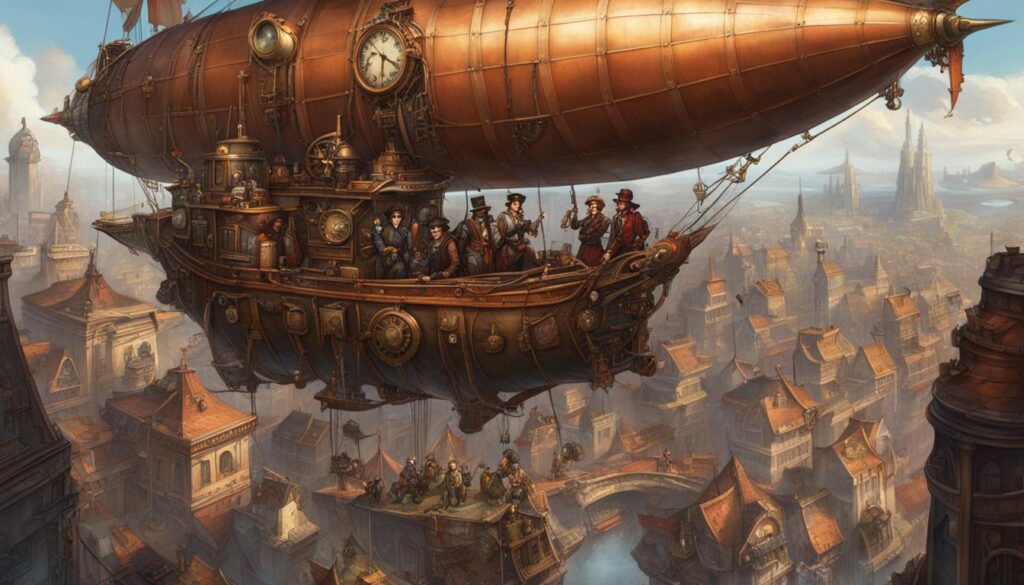
With its unique blend of historical elements, imaginative technology, and captivating aesthetics, steampunk in fantasy literature continues to attract readers looking for intellectually stimulating narratives and visually stunning worlds. The appeal of steampunk-infused fantasy stories lies not only in their captivating themes and settings but also in their ability to challenge traditional norms and explore social issues. As the genre evolves and authors continue to push the boundaries of storytelling, the allure of steampunk in fantasy literature is sure to endure.
Different Approaches to Writing Steampunk in Fantasy Literature
When it comes to writing steampunk in modern fantasy literature, authors have the freedom to explore various approaches and combine different genres. Some writers choose to focus on the alternate history aspect of steampunk, creating intricate worlds that are based on real historical events but with a twist of fantasy. This allows for the blending of real-life figures and events with imaginative elements, providing readers with a unique and captivating reading experience.
Others prefer to merge steampunk with traditional fantasy elements, such as magic and supernatural creatures. This fusion of genres opens up endless possibilities for storytelling, as authors can create fantastical worlds filled with intricate clockwork machinery, airships soaring through the skies, and magical beings harnessing the power of steam.
In addition to these approaches, some authors experiment with different settings outside of the traditional Victorian London backdrop. They may choose to set their stories in the American West, an alternate history China, or even on fictional planets. By doing so, they can explore new cultures, customs, and societal structures, adding depth and richness to their narratives.
Examples of Different Approaches to Writing Steampunk in Fantasy Literature
| Approach | Examples |
|---|---|
| Alternate History | 1. “Leviathan” by Scott Westerfeld 2. “The Difference Engine” by William Gibson and Bruce Sterling |
| Fusion with Fantasy | 1. “The Iron Duke” by Meljean Brook 2. “The Golem and the Jinni” by Helene Wecker |
| Exploration of Other Cultures | 1. “The Alchemist of Loom” by Elise Kova 2. “Stormdancer” by Jay Kristoff |
By adopting different approaches to writing steampunk in fantasy literature, authors can create diverse and engaging stories that enthrall readers. The genre’s blend of historical elements, imaginative technology, and fantastical themes continues to captivate audiences, making steampunk in modern fantasy literature a beloved subgenre that pushes the boundaries of storytelling.
Making Your Steampunk Writing Stand Out in Fantasy Literature
When delving into the world of steampunk in fantasy literature, it’s essential to find ways to make your writing stand out. Embracing the distinctive elements of steampunk while adding your unique twist can captivate readers and set your work apart from the rest. To achieve this, consider incorporating different types of stories into your narrative. For example, you could explore a steampunk war story or a medical drama set in a steampunk world. By venturing beyond traditional Victorian London settings, such as the American West or an alternate history China, you can add freshness and intrigue to your writing.
In crafting your steampunk-infused fantasy world, pay attention to creating well-developed settings. Immerse your readers in a vivid and detailed environment, where steam-powered machinery and fantastical elements coexist harmoniously. Strong characters are also crucial to drawing readers into your story. Develop complex and relatable individuals who navigate the challenges of both technology and magic.
A coherent plot that ties everything back to the steampunk elements is essential. Weave intricate storylines that allow the steampunk themes to shine and play a significant role in the narrative. Balancing the elements of fantasy and steampunk will help create a harmonious blend that appeals to readers.
| Pro Tip |
|---|
| “Find ways to incorporate the excitement and adventure that steampunk fans crave. Allow your enthusiasm for the genre to shine through in your writing, and never be afraid to push the boundaries of what’s possible within the steampunk and fantasy crossover.” – Steampunk Enthusiast |
Making your steampunk writing stand out in fantasy literature requires a combination of thoughtful world-building, compelling characters, and a mastery of the unique elements that define the genre. By infusing your work with enthusiasm and creativity, you’ll create an immersive experience for readers, drawing them into a world where imagination and technology collide.
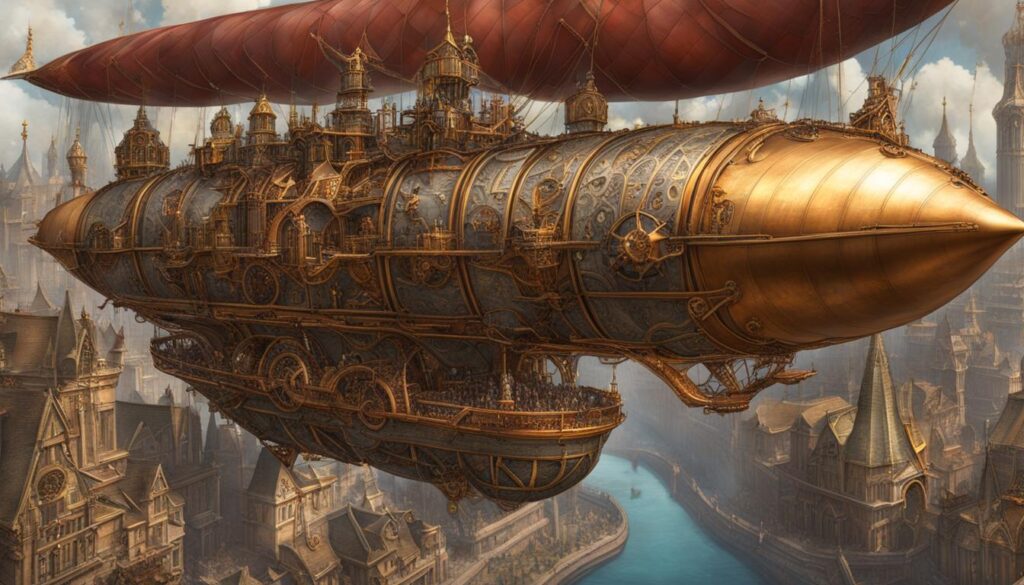
Recommended Reading
- The Art of Steampunk: Extraordinary Devices and Ingenious Contraptions from the Leading Artists of the Steampunk Movement
- Steampunk! An Anthology of Fantastically Rich and Strange Stories
- The Difference Engine
Conclusion
Steampunk has seamlessly intertwined with the realm of fantasy literature, leaving an indelible mark on the genre. With its fusion of Victorian charm, imaginative technology, and social critique, steampunk has revolutionized the way we perceive and indulge in fantasy stories.
The allure of steampunk in the world of literature lies in its ability to transport readers to a bygone era, where vintage aesthetics mesh with anachronistic machinery. The rich tapestry of steampunk-infused worlds, powered by steam and propelled by imagination, has captivated audiences and shaped fantasy literature in unprecedented ways.
Its impact on the genre is evident in the rise of fantasy-steampunk hybrids, where the best of both worlds converge to create stories that are as intricate as clockwork and as breathtaking as a maiden’s first flight on an airship. Steampunk has also brought forth a fresh perspective on Victorian society, allowing authors to explore social issues and offer commentary on the consequences of technological advancement, all within the fantastical realm of their creations.
As the steampunk movement continues to gain momentum, it is clear that its presence in fantasy literature will endure. So, let the gears turn, the steam whistle blow, and the fantastical tales unfold. Steampunk’s impact on the fantasy genre is here to stay, enchanting readers with its unique blend of vintage aesthetics, anachronistic innovation, and limitless possibilities.
FAQ
What is steampunk in literature?
Steampunk in literature is a genre that combines science fiction and fantasy elements with a historical setting, typically featuring steam-powered machinery.
How has steampunk transformed fantasy literature?
Steampunk has revolutionized the fantasy genre by introducing unique themes, settings, and characters, blending historical charm, imaginative world-building, and alternative history.
What are the key elements of steampunk in fantasy books?
Steampunk in literature is characterized by its homage to vintage fashion and anachronistic technological features, often exploring alternative histories and dystopian societies.
How has steampunk influenced modern fantasy literature?
Steampunk has evolved to become a prominent feature in modern fantasy literature, inspiring immersive worlds filled with clockwork contraptions, airships, and steam-powered technology.
What is the appeal of steampunk in fantasy literature?
Steampunk’s combination of historical elements, imaginative technology, and unique aesthetics creates a sense of nostalgia, adventure, and visual splendor that resonates with readers.
How can authors incorporate steampunk into their fantasy storytelling?
Authors can embrace steampunk by blending it with different story types, exploring alternative settings, and infusing their enthusiasm into the narrative to create excitement and adventure.

